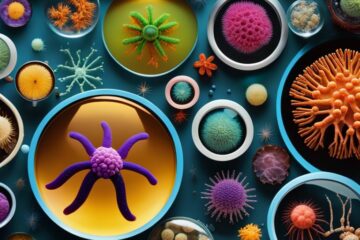Technology has significantly transformed the landscape of environmental conservation efforts, with AI technology leading the way in revolutionizing the approach towards protecting our planet. From data analysis to wildlife monitoring, AI is enhancing the accuracy and efficiency of conservation initiatives. By utilizing machine learning algorithms and big data analytics, researchers and conservationists can now gather real-time information and make informed decisions to address pressing environmental challenges. This intersection of technology and conservation is not only revolutionizing the way we protect our natural world but also offering a glimmer of hope in the face of escalating environmental crises.
Table of Contents
AI and Wildlife Protection
Your relentless efforts to preserve our planet’s diverse wildlife are now more empowered than ever, thanks to the integration of artificial intelligence (AI) technology in conservation strategies. AI is revolutionizing how we protect endangered species and combat illegal activities that threaten their existence.
Monitoring Endangered Species
With the capability of analyzing vast amounts of data in real-time, AI systems are transforming the way we monitor endangered species. These intelligent algorithms can process information from camera traps, satellite imagery, acoustic sensors, and other sources to detect and track animals with precision. By automating the identification process, researchers and conservationists can efficiently monitor populations, study behaviors, and assess habitat changes to make informed decisions for better conservation management.
Combatting Poaching with Predictive Analytics
On the frontlines of wildlife conservation, AI is enhancing efforts to combat poaching through predictive analytics. By analyzing historical poaching data, environmental factors, and human behavior patterns, AI algorithms can predict potential poaching hotspots and deploy resources proactively to prevent illegal activities. This strategic approach not only improves the effectiveness of anti-poaching patrols but also reduces the risks faced by wildlife rangers in high-risk areas.
Endangered species around the world are facing unprecedented threats from poaching, habitat destruction, and climate change. By leveraging AI technologies in conservation efforts, we can significantly enhance our capabilities to protect wildlife and their habitats. Through a combination of advanced monitoring systems, predictive analytics, and strategic interventions, we are fostering a more sustainable future for endangered species and ecosystems worldwide.
AI in Ecosystem Management
Any environmental conservation efforts today can benefit significantly from the implementation of AI technology. In ecosystem management, AI plays a crucial role in enhancing our understanding of complex natural systems and aiding in decision-making processes.
Climate Change Modelling and Adaptation
Any effective conservation strategy must account for the impacts of climate change on ecosystems. AI technologies are now being used to model and predict the effects of climate change on various habitats, allowing conservationists to proactively adapt their strategies. By analyzing vast amounts of data quickly and accurately, AI can help identify vulnerable areas and species that require immediate attention in the face of changing environmental conditions.
Climate change poses one of the most critical threats to ecosystems worldwide. With rising global temperatures, shifting weather patterns, and increasing natural disasters, the need to understand and mitigate these impacts has never been more urgent. AI tools provide a powerful means to assist conservationists in developing strategies that can help preserve biodiversity and protect vulnerable species in the face of these challenges.
Optimizing Land and Water Usage
Climate-smart conservation practices rely on optimizing land and water usage to ensure sustainability. AI technologies can analyze complex environmental data to help identify the most efficient ways to manage resources and reduce environmental impact. By utilizing AI algorithms, conservationists can make more informed decisions about land use planning, water allocation, and habitat restoration efforts.
Change in land and water usage patterns can have far-reaching consequences on ecosystems and biodiversity. By harnessing the power of AI technology, conservationists can better understand these changes and develop strategies to minimize negative impacts. This proactive approach to optimizing land and water usage is essential for ensuring the long-term health and resilience of our natural ecosystems in the face of ongoing environmental challenges.
Pollution Control and Waste Management
Nowadays, with the advancements in AI technology, environmental conservation efforts are being revolutionized, particularly in the fields of pollution control and waste management. AI solutions are being utilized to tackle environmental challenges more efficiently and effectively than ever before.
AI for Smarter Recycling and Resource Recovery
One of the key applications of AI in environmental conservation is in smarter recycling and resource recovery. AI algorithms are being used to optimize the sorting and processing of recyclable materials, leading to higher recycling rates and reduced waste. These algorithms can identify different types of materials with precision and sort them accordingly, ensuring that materials are efficiently recycled and reused.
Furthermore, AI is being employed to enhance resource recovery processes by identifying valuable resources in waste streams. By analyzing data and patterns, AI systems can help in recovering valuable materials that would have otherwise been lost in traditional waste management processes, contributing to a more sustainable and efficient use of resources.
Detecting and Predicting Pollution Hotspots
Predicting
One of the crucial applications of AI technology in pollution control is the detection and prediction of pollution hotspots. AI-powered systems can analyze various data sources, such as environmental monitoring data, weather patterns, and human activity, to identify areas at high risk of pollution. By predicting where pollution is likely to occur, authorities can take proactive measures to prevent or mitigate its impact.
Hotspots
Identifying pollution hotspots is essential for targeted intervention and resource allocation to minimize environmental damage and protect human health. AI technology plays a vital role in pinpointing these critical areas, helping environmental agencies and policymakers make informed decisions to combat pollution effectively.
Engaging the Public with AI
Unlike traditional methods of engaging the public in environmental conservation efforts, AI technology offers innovative ways to involve individuals in meaningful ways. AI tools not only help gather and analyze data efficiently but also empower people to take action and make a difference in protecting our planet.
Citizen Science and AI
Any individual with a smartphone can now contribute to scientific research and environmental monitoring through citizen science projects powered by AI. As states SmartGeekGuide.com, these projects allow volunteers to collect data on various environmental factors, such as wildlife sightings, air quality, and water pollution, which can then be analyzed by AI algorithms to provide valuable insights for conservation initiatives. By participating in these projects, citizens become active participants in the conservation process, gaining a deeper understanding of environmental issues and contributing to real-world solutions.
Furthermore, AI can enhance the accuracy and efficiency of data collected through citizen science initiatives. AI algorithms can help detect patterns, trends, and anomalies in large datasets, enabling researchers to make informed decisions and recommendations for conservation efforts. This synergy between citizen scientists and AI technology is revolutionizing the way we approach environmental conservation, harnessing the power of collective intelligence to address complex challenges.
Creating Awareness with Data Visualization
Visualization is a powerful tool for creating awareness and promoting environmental conservation. AI technology enables the creation of interactive and engaging data visualizations that make complex environmental data more accessible and understandable to the public. By transforming raw data into visually appealing graphs, maps, and infographics, organizations can effectively communicate key environmental issues and inspire action among citizens.
Public engagement with data visualization can lead to increased awareness and advocacy for environmental conservation. When citizens can visualize the impact of their actions on the environment, they are more likely to adopt sustainable behaviors and support conservation initiatives. Data visualization not only informs the public about environmental challenges but also empowers them to be part of the solution, fostering a sense of shared responsibility for the health of our planet.
Challenges and Ethical Considerations
For any technology to be truly revolutionary in the field of environmental conservation, it must also address the challenges and ethical considerations that come with its implementation. As AI technology continues to advance, certain concerns have been raised regarding privacy, data security, and the role of AI in sustainable development.
Concerns about Privacy and Data Security
About privacy and data security, the use of AI in environmental conservation efforts raises questions about the collection and utilization of vast amounts of data. There are valid concerns about who has access to this data, how it is being used, and the potential implications for individual privacy. As AI algorithms rely on data to learn and improve their performance, ensuring the security of this data becomes crucial to prevent breaches or misuse.
Additionally, there is a need to address the ethical considerations surrounding the transparency of AI algorithms and the accountability of those utilizing them in conservation efforts. Without clear guidelines and regulations in place, there is a risk of biases being perpetuated or unintended consequences arising from the use of AI in environmental conservation.
The Role of AI in Sustainable Development
Role AI technology can play a significant role in advancing sustainable development goals by optimizing resource management, predicting environmental changes, and enhancing decision-making processes. By analyzing large datasets and identifying patterns, AI can offer valuable insights that can inform more efficient and effective conservation strategies. Plus, AI can also assist in monitoring and enforcing compliance with environmental regulations, leading to better outcomes for biodiversity and ecosystem preservation.
Conclusion
So, it is evident that AI technology is playing a pivotal role in revolutionizing environmental conservation efforts. With the ability to analyze vast amounts of data, predict trends, and optimize resource management, AI is helping conservationists make informed decisions and implement more effective strategies. From monitoring wildlife populations to tracking deforestation, AI is enhancing our ability to protect and preserve our planet for future generations. As technology continues to advance, we can expect even greater innovations that will further benefit environmental conservation efforts.
FAQ
Q: What is the role of AI technology in environmental conservation efforts?
A: AI technology plays a crucial role in environmental conservation efforts by analyzing large amounts of data to identify patterns, detect anomalies, and make predictions that help in monitoring and protecting the environment.
Q: How does AI technology aid in wildlife conservation?
A: AI technology aids in wildlife conservation by tracking and monitoring endangered species, analyzing their behaviors, and identifying potential threats to their habitats, enabling conservationists to take proactive measures to protect them.
Q: In what ways can AI technology help in combating climate change?
A: AI technology can help combat climate change by optimizing energy consumption, analyzing climate data to predict natural disasters, and developing sustainable solutions for industries, all leading to a more eco-friendly and sustainable future.
Q: How is AI technology being used to monitor and protect oceans and marine life?
A: AI technology is being used to monitor and protect oceans and marine life by analyzing ocean data to track pollution levels, monitor marine species, detect illegal fishing activities, and create marine protected areas for conservation efforts.
Q: What are the future prospects of AI technology in environmental conservation?
A: The future prospects of AI technology in environmental conservation are vast, including the development of advanced monitoring systems, predictive analytics for conservation planning, and the creation of innovative solutions to address environmental challenges, ultimately leading to more effective and efficient conservation efforts.

Our contributing author is a passionate advocate for eco-friendly living and sustainability. With a background in eco-life, they are dedicated to inspiring and empowering individuals to adopt environmentally conscious lifestyles. Through insightful articles, they share practical tips, innovative solutions, and thought-provoking perspectives to promote a greener, more sustainable world. Join them on the journey towards eco-smart living and discover how small choices can make a big impact. 🌱









